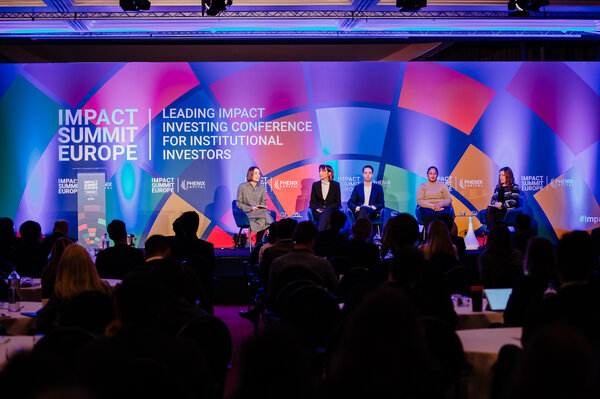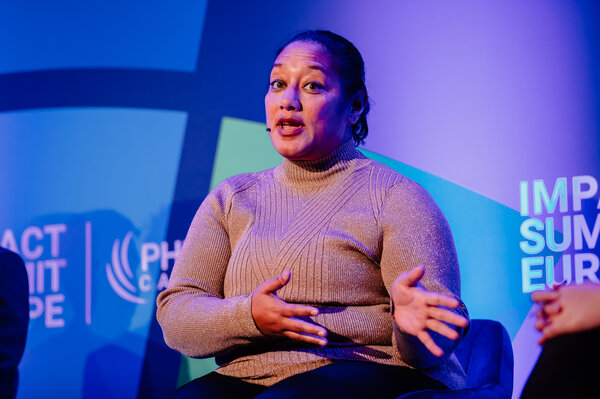Impact: key takeaways from the Phenix Impact Summit 2023
The Phenix Impact Summit is the leading impact investing conference for institutional investors. It brings together thought leaders and practitioners in impact investing with the objective to catalyse private institutional capital in support of the United Nations Sustainable Development Goals.
The Phenix Capital Impact Summit is the leading impact investing conference for institutional investors. It brings together thought leaders and practitioners in impact investing with the objective to catalyse private institutional capital in support of the United Nations Sustainable Development Goals.
Dimple Sahni, Managing Director of Multi-Asset Impact at Anthos Fund & Asset Management (Anthos) took part in the ”Private vs Public markets” panel discussion, whilst Managing Director of Multi-Asset Impact Diana Wesselius and senior Impact analyst Milena Levicharova, CFA also attended.
Here, the Anthos impact team shares their key takeaways from the summit.
Date: 28 – 29 March 2023 | Location: The Hague
-
Current state of impact investing: Pensions funds and asset managers continue to progress their views and strategies towards impact investing. Actual deployment of larger institutions towards impact seems to be limited still to less than 5% of assets under management. Some investors are increasingly aligning investments to frameworks like the United Nations’ Sustainable Development Goals (SDGs), whilst others are setting up teams to get involved in development of assets to address perceived gaps in the market.
-
Market leadership: We note a shift in leadership from the EU to the US. Whilst the EU has been a thought leader, the US has led on action with the Inflation Reduction Act in 2022. There is regression in progress towards achieving SDGs due to the COVID-19 pandemic and the Russia/Ukraine war, which the US is less exposed to. These developments indicate that investors in Europe need to step up in order to ensure the efforts towards achieving the SDG’s are successful.
-
Public versus private debates: The public vs private markets debate is ongoing, which we took part in at the conference. Our take is that more and more people are seeing the logic and need for an all-weather portfolio that includes a total asset allocation. The key reasons for this are scale, liquidity and deployment risk, as well as democratisation of impact investing so it is not simply limited to those accredited investors who have the know-how and contacts to invest in the illiquid markets.
-
Next-gen views on impact investing: The younger generation is more interested in impact investing and wants to do it in a bolder, faster way. They are looking to invest with firms that offer inclusivity, authenticity, and impact.
-
Emerging market healthcare and affordable housing: There is still a perception of higher risk and scepticism for commercial returns, resulting in funding gaps. We need more viable investment solutions to address this.
-
Nature-based solutions: Nature-based solutions provide stable returns and a hedge in this inflationary environment. Biodiversity in Brazil was mentioned as a good strategic option.
-
Impact evaluation and strategy: When defining impact strategy, it is important to consider how to operationalise it and whether to focus towards certain impact themes for different asset classes. It is also relevant to consider democratisation of return when conducting impact due diligence, especially as relates to carry allocation for financial and impact returns. This aligns with our thinking, based on more than a decade’s worth of practitioner experience, that impact happens differently in different asset classes. That’s why we developed a multi-asset portfolio approach to impact investing in order to optimise the levels of impact generation we could achieve across the financial markets. Read our thought piece on this topic here.
-
Impact measurement: The Global Impact Investing Network Impact Lab (GIIN Lab) is building a database of impact performance, creating benchmarks that allow for contextualisation of impact results. The pilot is still in early stages and we continue to follow this initiative closely.
-
Sustainable Financial Disclosure Regulation (SFDR): SFDR classification is both a burden and an opportunity. A burden as it requires extensive data collection that is generally perceived as complex, and resource intense. And opportunity, as it will lead to full transparency on impact goals and results achieved.
- Anthos portfolio and pipeline: We very much enjoyed connecting face-to-face with some of our portfolio managers. In addition, we met with several exciting prospective opportunities which may be a good fit for our impact strategy based on our focus impact themes. The range was considerable: from aquatic agriculture, to well-thought out technology-focused impact strategies, to emerging market impact bond strategies, to climate solutions.

